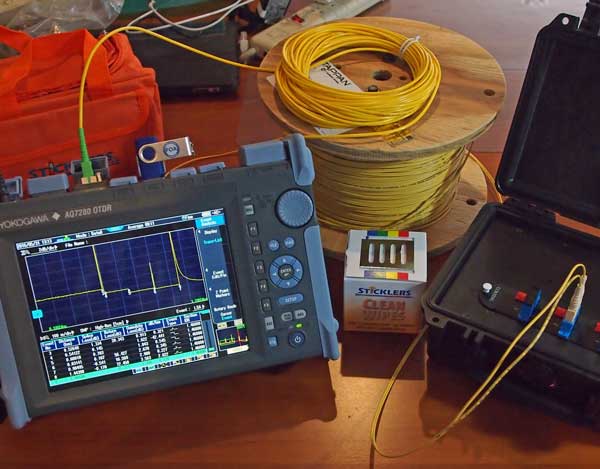Crucial Features to Try To Find in Optical Fiber Testing Devices
When evaluating optical fibre screening tools, numerous important attributes warrant cautious factor to consider to ensure optimal performance and reliability. Compatibility with existing market standards improves capability, while sophisticated measurement capabilities, including TDR and OTDR testing, deal vital insights into network stability. Recognizing these features will lose light on just how to pick the appropriate equipment for your specific requirements.
Accuracy and Precision
Precision and accuracy are vital criteria in the examination of optical fibre testing devices. These two qualities make sure that dimensions mirror truth performance of fibre optic systems, which is crucial for efficient network installment, maintenance, and troubleshooting. Precision refers to the nearness of a gauged value to the real value, while precision represents the repeatability of measurements under the same conditions.
When choosing optical fiber screening equipment, it is important to think about tools that give high accuracy and precision to reduce errors in information interpretation. Devices such as optical time-domain reflectometers (OTDRs) and power meters must have calibration mechanisms to guarantee regular efficiency gradually. Furthermore, the specs provided by producers should information the devices's measurement unpredictability, which straight affects the integrity of test results.
Furthermore, the efficiency of optical fiber testing tools can be affected by environmental factors, such as temperature and humidity. For that reason, selecting devices designed to mitigate these variables will improve measurement fidelity. Finally, spending in optical fibre testing tools with robust accuracy and precision features is fundamental for preserving optimal network performance and making sure the honesty of fibre optic interactions.

User-Friendly Interface
The performance of optical fiber screening devices is not exclusively figured out by its accuracy and precision; an user-friendly user interface plays a significant duty in improving operational performance. A properly designed user interface simplifies the communication between the specialist and the devices, enabling an extra intuitive understanding of intricate functions.
Secret features of a straightforward user interface consist of clear navigation food selections, logical designs, and conveniently accessible controls. These aspects make it possible for professionals to execute examinations promptly without extensive training, reducing the likelihood of individual error - ofda. Aesthetic signs such as progress bars, notifies, and graphical representations of information can dramatically improve the user experience by providing prompt comments on the screening procedure.
Additionally, personalized settings can additionally streamline procedures by enabling users to adjust specifications according to details screening demands. This versatility not only conserves time yet likewise makes sure that the devices meets diverse application needs.
Including aid functions, such as tooltips and comprehensive guidebooks, into the interface can additionally equip users, advertising self-sufficiency and confidence in running the tools. Ultimately, an user-friendly interface is necessary for taking full advantage of the potential of optical fiber testing devices, leading to extra effective and effective testing outcomes.
Portability and Sturdiness
Transportability and longevity are essential characteristics of optical fiber screening tools, ensuring that it can withstand the rigors of numerous atmospheres while remaining very easy to transportation. Service technicians frequently work in varied setups, from telecoms hubs to remote installments, making it imperative that screening tools are lightweight and compact (ofda). Devices made with transportability in mind typically includes ergonomic manages and situations imp source that promote easy motion, hence enhancing operational efficiency on-site
Longevity is just as crucial, as optical fiber screening devices is frequently revealed to rough problems, consisting of temperature level fluctuations, wetness, and physical impacts. Devices constructed with sturdy materials such as reinforced plastics or metal housings are better suited for these settings, reducing the threat of damage during usage and transport. Additionally, devices with water and dust resistance rankings, such as IP scores, ensures reliable efficiency in challenging problems.
Compatibility With Specifications
Guaranteeing compatibility with market criteria is important for optical fibre testing tools, as it straight influences the reliability and credibility of examination outcomes. Optical fiber networks undergo stringent efficiency criteria established by different organizations, including the Telecoms Market Organization (TIA) and the International Electrotechnical Payment (IEC) Testing equipment must stick to these standards to guarantee that dimensions correspond and similar across different systems and environments.
When choosing optical fibre testing equipment, customers need to validate that the tool fulfills pertinent criteria relevant to their particular application, such as those associated to depletion, transmission capacity, and crosstalk. Devices that is certified with recognized requirements not only assists in attaining precise results yet additionally assists in interoperability among devices from various producers.
Furthermore, compatibility with standards ensures that the equipment can be utilized in regulative conformity circumstances, which is vital for tasks in fields such as telecommunications, aerospace, and military applications. Investing in optical fiber screening equipment that straightens with present industry standards is discover this a fundamental facet of maintaining top quality guarantee and accomplishing optimum network efficiency.
Advanced Dimension Capabilities
Advanced dimension capacities are a defining feature of modern-day optical fibre testing tools, enabling detailed evaluation of network efficiency. These my link abilities guarantee that technicians can evaluate critical specifications such as signal loss, diffusion, and transmission capacity, which are crucial for maintaining ideal communication effectiveness.
One key element is the ability to conduct time-domain reflectometry (TDR) and optical time-domain reflectometry (OTDR) tests. These strategies allow individuals to recognize mistakes, determine the size of fibers, and figure out the place of flaws with amazing precision - ofda. Moreover, innovative devices typically includes the ability to determine optical power levels, helping to analyze the overall wellness of the network and make sure compliance with the called for specs.
In addition, some screening devices supply innovative formulas for real-time evaluation, making it possible for quicker medical diagnosis and troubleshooting. In final thought, investing in optical fibre testing equipment with innovative measurement capacities is necessary for making sure network integrity and performance in today's demanding telecommunications landscape.
Conclusion

Comments on “OFDA Systems for Improving Fibre Analysis in Manufacturing Processes”